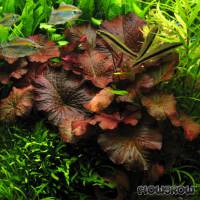



The water lily Nymphaea lotus "red" or N. zenkeri "red" is native to the African tropics, where it is found in stagnant waters like lakes or temporary ponds. In aquaristics, it is by far the most popular species of its genus, and correspondingly well available in trade. It is also known under the name red tiger lotus.
- To be continued -
(For further informations, see "Culture" and "Design")
Nymphaea lotus "rot" is a bulbous plant that grows submersed as well as floating leaves. Even if it grows under low light it is recommendable to provide it with more light if you want to prevent it from growing floating leaves. If it does grow floating leaves you should quickly act and cut them off. If the water lily once reaches the water surface it grows almost exclusively floating leaves.
Continual cutting off these leaves will break this habit. A nutrient-rich soil is especially important for water lily cultivation. CO2 injection and the addition of liquid fertilisers are also welcomed. Under optimal conditions, Nymphaea lotus "red" grows very large, and most hobbyists have to keep it in check. A very popular method is planting the water lily in a pot that is then placed in the aquarium substrate. The limited root space stunts the plant's growth.
N. lotus "red" is mainly propagated by seed. Therefore, the plant must be allowed to form some floating leaves in order to form flowers. These flowers can be pollinated by hand and then produce the seeds.
The bulb can also be cut apart, however, this should only be done if a second leaf crown has formed. This propagation method cannot be recommended, as the mother plant might die off.
The enormous size this plant can reach limits its use. However, its red colour contrasts beautifully against green plants, and its size makes it a good focal point. Nymphaea lotus "red" requires a little maintenance, but then it is a beautiful aquarium plant, mainly for large tanks.
References and further reading:<a href="https://www.flowgrow.de/db/aquaticplants/nymphaea-lotus-rot" target="_blank"><img alt="Nymphaea lotus 'rot'" title="Nymphaea lotus 'rot'" src="https://www.flowgrow.de/db/widget/aquaticplants/nymphaea-lotus-rot" /></a>
[url=https://www.flowgrow.de/db/aquaticplants/nymphaea-lotus-rot][img]https://www.flowgrow.de/db/widget/aquaticplants/nymphaea-lotus-rot[/img][/url]
[widget=aquaticplants/nymphaea-lotus-rot]Nymphaea lotus 'rot'[/widget]